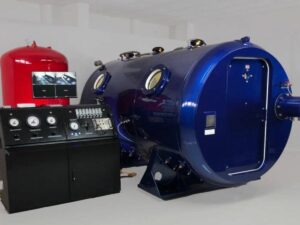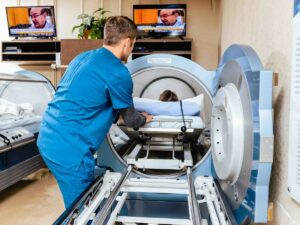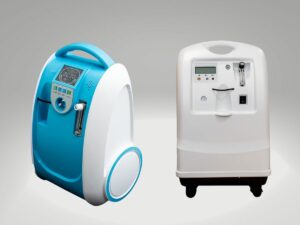As we all know, hyperbaric oxygen therapy involves inhaling oxygen at a pressure higher than one atmospheric pressure in a closed chamber to treat diseases. Thus, hyperbaric oxygen therapy is inseparable from the oxygen chamber and its related equipment. The development of hyperbaric oxygen medicine relies heavily on the continuous updates and improvements made to hyperbaric oxygen equipment.
Since the construction of the world’s first copper hyperbaric oxygen chamber by the French Junod in 1834, hyperbaric oxygen chamber equipment has reached a fairly mature level. This advancement has significantly contributed to the progress of hyperbaric oxygen medicine, taking it to higher and deeper levels of treatment and understanding.
1. Types of Hyperbaric Oxygen Chambers
Hyperbaric oxygen chambers can be classified into two main types based on the pressurized substances used in the chambers: air pressurized chambers and pure oxygen chambers. Within these categories, there are several specific types:
- High-pressure air chamber
- Small high-pressure air chamber
- Hyperbaric oxygen chamber
- Infant hyperbaric oxygen chamber
- Animal experiment hyperbaric oxygen chamber
- Diving pressurized chamber
- Low-pressure chamber
- High and low-pressure dual-purpose chamber
- Diving pressurized chamber group
Each type of chamber serves different purposes and applications.
2. Basic components of a hyperbaric oxygen chamber
The most basic process of hyperbaric oxygen therapy involves using an air compressor to filter high-pressure air and pump it into an air storage tank for backup. During hyperbaric oxygen therapy, the high-pressure air in the air storage tank is injected into the cabin through the air supply pipeline and the air filtration system, thus raising the pressure in the cabin to the required level for hyperbaric oxygen therapy.
Simultaneously, the oxygen supply system is activated. At this point, the patient inhales hyperbaric oxygen equal to the cabin pressure through the oxygen inhalation mask, completing the entire hyperbaric oxygen treatment process. The process is controlled by the operator of the console. Therefore, based on the system functions, the hyperbaric oxygen chamber equipment can be divided into the following major systems: supply and exhaust system, oxygen supply and exhaust system, cabin and auxiliary system, and control system.
Additionally, the hyperbaric oxygen chamber equipment can be categorized based on functional composition, including the cabin body part, the air pressure reduction part, the oxygen supply and exhaust part, the oxygen chamber electrical part, the oxygen chamber air conditioning part, and the oxygen chamber fire protection and emergency decompression part.

3. How a Hyperbaric Oxygen Chamber Works
Cabin Equipment
The cabin serves as the main carrier for hyperbaric oxygen therapy, where all treatments take place, making it the fundamental component of the entire medical air pressurized cabin. Constructed from welded steel plates using compatible welding rods, all welding links must adhere strictly to regulations and national standards, and the cabin must pass a hydrostatic test. The oxygen chamber shell is crucial and can be either cylindrical or elliptical in structure.
Patients enter and exit the cabin through the door, which can be opened separately using mechanical or electric locking devices. Plexiglass-covered windows include lighting, monitoring, and observation windows. The delivery tube acts as a channel for transferring items inside and outside the oxygen chamber, while the through-cabin hole connects various pipes and electrical outlets.
Air Pressure and Pressure Reduction Equipment
Atmospheric air is drawn through the air inlet of the air compressor, compressed in the cylinder by the motor to increase the pressure, and then discharged from the air outlet. However, the compressed air contains impurities like oil and water and does not meet the air source quality requirements of medical air pressurized cabins.
To improve air quality, it undergoes treatment in a cold dryer, which freezes and dries the compressed air, causing most oil vapor and water vapor to condense and precipitate. The air then passes through an oil-water separator for further purification. The separator’s baffles separate impurities like oil and water from the compressed air, which is then discharged through the exhaust port into the air storage tank.
After further purification through precipitation in the air storage tank and passing through the air filter, the cleaned compressed air enters the cabin to increase the pressure. During pressurization, the gas source is activated, the pressure reducing valve is closed, and the pressurization valve is opened. Conversely, during decompression, the pressurization valve is closed, and the decompression valve is opened to depressurize the oxygen chamber.

4. Oxygen Supply and Exhaust Equipment
Oxygen Supply
The oxygen source provides stable pressure and sufficient flow. The general oxygen source pressure ranges from 0.4 to 0.6 MPa. Copper or stainless steel pipes connect the oxygen source and the oxygen chamber, entering the chamber through the oxygen chamber’s flange and connecting to the oxygen inhalation device. Patients use the mask, tee, and oxygen inhalation tube to inhale oxygen.
Oxygen Exhaust
Oxygen exhaust operates on the principle of negative pressure. High-speed airflow passing through a pipe with a small hole generates negative pressure, allowing air outside the pipe to enter through the hole. The main oxygen exhaust pipe in the oxygen chamber connects to each patient’s oxygen exhaust pipe, which has a hole at its innermost end.
As a result, during oxygen exhaust, the difference in pressure inside and outside the chamber creates a high-speed airflow outside the chamber in the main oxygen exhaust pipe. This forms negative pressure in the patient’s oxygen exhaust pipe, discharging waste oxygen. The oxygen exhaust valve regulates negative pressure, ensuring it is not too large.
Oxygen Chamber Electrical Equipment
The electrical components within the cabin can only operate on direct current. When connecting the external electrical components to the mains, isolation by a transformer is essential. Additionally, a UPS uninterruptible power supply is necessary to provide lighting and intercom power supply during power outages.
Oxygen Chamber Snatch Adjustment Equipment
Air temperature adjustment primarily relies on the air conditioner, which only includes coils and fan blades within the cabin. The remaining electrical and mechanical parts of the air conditioner are located outside the cabin, with the fan blades powered by an electric motor.
Oxygen concentration and air quality adjustment depend on ventilation. Ventilation uses fans to filter cabin air, facilitating internal circulation. Ventilation involves discharging air from the cabin while simultaneously supplying clean air from the air source into the cabin, thereby maintaining dynamic cabin pressure stability.
Computer-Controlled Equipment
Computer control consists of two parts: software and hardware. The hardware includes an industrial computer, A/D converter, D/A converter, sensor, actuator, and other components. The control software handles the collection, reading, display, and storage of pressure, oxygen concentration, temperature, and humidity values. It also manages control signal transmission and can be written in languages such as c++, VB, or Delphi, with most codes written in Delphi.
5. Development Status of Hyperbaric Oxygen Chamber
Oxygen Chamber Equipment
The cabin, as a whole, has evolved towards aesthetics, lightweight, and high quality. The toughness and strength of the steel used have significantly improved.
The hatch door is one of the most important parts of the cabin body. Previously, mechanical doors were more common, which were relatively heavy and wore out quickly. In recent years, electric and electromagnetic hatch doors have been developed, which require power to function properly. From a material perspective, most newly-built oxygen chamber doors are thin-shell doors. These doors are easy to manufacture, look beautiful, lightweight, and easy to close.
However, uneven placement of the rubber pad can cause issues such as loose door closing and air leakage. Additionally, the locking method of the cabin door has evolved from the rocker pressing type to the spring lock type. The latter saves effort, makes it easy to close the door, and reduces wear and tear. Nevertheless, if the main and auxiliary cabins are pressurized separately, it can lead to a door that is not tightly closed and may cause air leakage.
The principle of the delivery tube has not changed much, but continuous improvements have made it lighter, more aesthetically pleasing, and more convenient.
Air Pressure and Pressure Reduction Equipment
The air compressor is one of the most important pieces of equipment in the hyperbaric oxygen chamber. It has transitioned from traditional piston compressors to screw compressors. Piston air compressors have disadvantages such as high noise, high oil content in compressed air, and high failure rates, but they can provide at least 3MPa pressure through multi-stage compression. On the other hand, screw air compressors The cold dryer is a device used to cool the compressor. In the past, passive cooling methods like air cooling and water cooling were mainly used. However, active cooling methods involving refrigerators are now more prevalent. Air-cooled and water-cooled equipment have lower costs but larger volumes, are susceptible to corrosion, and have inferior freeze-drying effects. On the other hand, refrigeration refrigeration equipment has higher costs, smaller size, cleanliness, and hygiene. It is less prone to failure and has excellent freeze-drying effects.
The oil-water separator is mainly developed towards miniaturization, leading to improved oil removal and water filtration performance.
The air filter is also moving towards miniaturization, with improved filtration quality at the micron level.
The pressure-reducing valve has evolved from a simple solenoid valve to a combination of mechanical throttle valve, solenoid valve, and pneumatic film regulating valve. This allows for manual adjustment of airflow speed, while the pneumatic film regulating valve uses electric current for remote airflow control.
Oxygen Supply and Exhaust Equipment
The oxygen source has evolved from a simple oxygen bottle with a bus bar to centralized oxygen supply using a liquid oxygen tank. The method of oxygen cylinder plus busbar is cost-effective and occupies less space but requires frequent cylinder replacements. On the other hand, the centralized oxygen supply method with a liquid oxygen tank requires a larger initial investment, specific equipment, and more space. However, one-time filling of liquid oxygen can provide oxygen supply for a longer period.
Comparing the two methods in terms of economic benefits, the liquid oxygen tank is advantageous in terms of equipment space and preparation effort, as well as oxygen purity. However, it may be more challenging to detect and repair failures in the liquid oxygen tank.
| Equipment Type |
Purpose |
Features/Specifications |
| Oxygen Concentrator |
Supplies nearly pure oxygen by removing nitrogen from ambient air |
Portable or stationary, produces 90-95% pure O2 |
| Oxygen Cylinders |
Stores pure oxygen under pressure for immediate use |
Available in various sizes, high-pressure storage |
| Oxygen Mask |
Deliver oxygen directly to patients |
Can be simple, non-rebreather, or Venturi |
| Exhaust Fans |
Removes stale air and ensures fresh air circulation |
Different sizes and power ratings, wall or ceiling mounted |
| Oxygen Exhaust Ventilators |
Removes excess oxygen from environments (like hyperbaric chambers) |
Controlled vents, sensors for oxygen concentration |
Oxygen Chamber Electrical Equipment
Intercom
Most newly-built oxygen chambers use power amplifiers and two-way walkie-talkies for voice communication inside and outside the cabin, enabling two-way calls with just one walkie-talkie.
Lighting
There are various lighting methods, with most of them being external lighting. The light sources have evolved from the first generation of incandescent lamps and fluorescent lamps to the second generation of energy-saving lamps, LED lamps, and the third generation of optical fiber lighting. The second generation reduces energy consumption and damage to the lighting window, preventing premature aging of the equipment.
The LED lamp body hardly produces heat, has high brightness and low power, and is cost-effective. The third generation has also changed from end-face lighting to side overall lighting, providing uniform light and a good overall lighting effect. It is a development direction of oxygen chamber lighting, but the equipment cost of fiber optic lighting is high.

Oxygen Chamber Air Conditioning Equipment
The latest technology of the air conditioner in the oxygen chamber is a high-power ceiling type, ensuring rapid cooling during pressurization and rapid heating during decompression. The rotation of fan blades can be powered either by the electric motor outside the cabin or the air motor inside the cabin.
Operation Mode
The cabin operation method has evolved from primitive manual operation to solenoid valve remote control, single-chip microcomputer + relay, and computer control.
Manual operation: This method is cumbersome, requires manual labor, cannot achieve uniform speed and stable pressure, and may result in valve pipes piling up near the operating table, making it visually unappealing.
Solenoid valve remote control: This method is relatively simple, but it lacks control over the speed of pressure addition and decompression. There are only remote control buttons near the console, and all solenoid valves can be installed at the bottom of the cabin.
Single-chip microcomputer + relay: It can realize the monitoring of various parameters of the oxygen chamber and achieve some degree of automatic control. However, the single-chip control strategy is simple, resulting in relatively lower control precision. The implementation method is relatively straightforward and common.
Computer control: Computer control can realize accurate monitoring of various parameters, offers diversified control strategies and high control precision, but the control system is complex and requires careful debugging.
6. Prospects for the Development of Hyperbaric Oxygen Chamber
Judging from the current development trend of hyperbaric oxygen chamber equipment, its development direction mainly includes the following aspects:
Continue to renovate and update the equipment of the hyperbaric oxygen chamber, focusing on intelligence, simplification, cleanliness, and aesthetics. The purpose is to make hyperbaric oxygen therapy safer, more convenient, and provide users with a more comfortable and efficient experience.
Develop different types of hyperbaric oxygen chambers according to actual needs, such as caisson operations, offshore oil drilling, first aid, and transfer of patients with decompression sickness. This has led to the emergence of portable hyperbaric oxygen chambers and hyperbaric oxygen ambulances.
The development and use of medical equipment inside the oxygen chamber, such as ventilators, monitors, and sputum suction devices, have broken the taboo that conventional medical equipment cannot enter the cabin. This allows various rescue equipment to be safely used inside the cabin, improves the level of treatment in the oxygen chamber, and expands the scope of treatment.
The development and progress of hyperbaric oxygen therapy are inseparable from the update and improvement of equipment. Additionally, the demand for clinical hyperbaric oxygen therapy has put forth requirements and motivation for the development of hyperbaric oxygen equipment. Oxygen medicine is advancing towards a higher, deeper, and better level.





